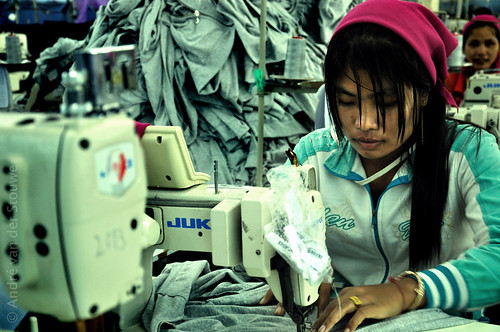Traditionally, policy makers have focused on creating jobs to reduce poverty, but jobs alone may not be sufficient. Job quality also matters, although creating "good" jobs is a huge challenge given the advent of global supply chains, which link thousands of firms extending across cultural and political boundaries. One area where there is a large and growing debate about globalization and labor standards is working conditions in apparel factories. At one extreme are those who argue that globalization erodes working conditions and reduces labor compliance in export-oriented sectors. At the other extreme are those who insist that free trade does not interfere with labor compliance. As it turns out, we are learning that good human resource policies may tip the scales.

The value of human resource policies
In response to growing public concern about "sweatshops" - which are typically associated with low wages, long hours, high temperatures, excessive noise, poor air quality, unsanitary conditions, and abuse (both verbal and physical) - several organizations have pressured governments and employers to improve working conditions. Public exposure, such as anti-sweatshop demonstrations in the 1990s, seems to have paid off in some developing countries. For example, in Indonesia, a study on the impact of these campaigns shows that they led to large real wage increases, although there were some costs in terms of reduced investment, falling profits, and increased probability of closure for smaller plants, but little significant effects on employment (Harrison and Scorse, 2010).
How about other aspects of employment besides wages, such as decent and healthy working conditions, and rights of association? A recent Massachusetts Institute of Technology study explored this question by comparing two pretty similar factories supplying Nike (both are in Mexico, produce more or less the same products for Nike and other brands, and are subject to the same code of conduct). On the surface, these factories appear to have similar employment practices, and they receive comparable scores when audited by Nike’s compliance staff. But the study shows that their actual labor conditions differ significantly. Beyond the code of conduct and various monitoring efforts aimed at enforcing it, workplace conditions and labor standards are shaped by very different patterns of work organization and human resource management policies (Locke et al., 2010). The promotion of these alternative work/human resource management practices can complement traditional monitoring efforts in ways that promote better labor standards.
While the term "human resource management practices" may inspire thoughts of administration and bureaucracy, in developing countries these policies shape and define job quality. Ichniowski et al. (1997) argue that adopting new human resource practices - such as work teams, flexible job assignments, employment security, training in multiple jobs, and extensive reliance on incentive pay - might be viewed as an aspect of production technology akin to shop-floor production technologies. As such, these practices may improve productivity, factory performance, and survival. Subsequent studies support the idea that better work practices can help survival (Brown et al. (2011, 2012).
The Better Work program
In 2001, the Better Factories Cambodia (BFC) program was created by the International Labor Organization (ILO) to monitor and help factories improve working conditions. It grew out of the 1999 U.S.-Cambodia bilateral trade agreement, which created an incentive for factories to improve working conditions by linking such improvements to greater access to the U.S. market. A number of recent studies document sustained increases in working conditions in Cambodia (Miller et al., 2009; Shea et al., 2010; Adler and Woolcock, 2010). Other studies show that the presence of a reputation-sensitive buyer and the policy of public disclosure of noncompliance increased the likelihood of compliance (Oka, 2010a and 2010b). In addition, overall, working conditions didn’t fall as the environment became more competitive (Beresford, 2009). One study even finds that ending the program of public disclosure reduced the rate of compliance, especially between the first and second visit (Ang et al., 2011).
Currently, targeted policies to improve human resource practices are widespread. The Better Work program (www.betterwork.org), which grew out of Better Factories Cambodia, has been one of the most significant programs. Run by the ILO and the International Finance Corporation (IFC), in close collaboration with local and international stakeholders, including unions and buyers, it has been growing over the past decade - with established operations in countries such as Bangladesh, Cambodia, Haiti, Indonesia, Nicaragua, Lesotho, Jordan, and Vietnam. It promotes and enforces labor standards and technical assistance to firms in apparel and textiles to increase their competitiveness in international markets. It also collects periodic data on workers, managers, and firm performance at the factory level as part of their monitoring and evaluation plan. The event that spawned both holidays occurred in Chicago on May 4, 1886, but different political dynamics reflect how they have come to be commemorated in different ways. What became known as the Haymarket Affair (or Haymarket Massacre) started as a peaceful rally in Haymarket Square to support workers that were striking for an 8-hour work day. It turned deadly when a bomb was thrown (the culprit is still unknown), followed by a shoot-out that killed several police officers and civilians. The trial was widely publicized, with eight anarchists sentenced to death on conspiracy charges.
Better Work has a significant presence in the apparel sector - for instance, all export apparel firms participate in Better Work Cambodia. It is also exploring extending its operations to other sectors, such as electronics and tourism.
This post was first published on the Jobs Knowledge Platform.


Join the Conversation